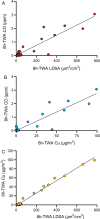Exposure to lead-free frangible firing emissions containing copper and ultrafine particulates leads to increased oxidative stress in firing range instructors
- PMID: 35570273
- PMCID: PMC9107651
- DOI: 10.1186/s12989-022-00471-0
Exposure to lead-free frangible firing emissions containing copper and ultrafine particulates leads to increased oxidative stress in firing range instructors
Abstract
Background: Since the introduction of copper based, lead-free frangible (LFF) ammunition to Air Force small arms firing ranges, instructors have reported symptoms including chest tightness, respiratory irritation, and metallic taste. These symptoms have been reported despite measurements determining that instructor exposure does not exceed established occupational exposure limits (OELs). The disconnect between reported symptoms and exposure limits may be due to a limited understanding of LFF firing byproducts and subsequent health effects. A comprehensive characterization of exposure to instructors was completed, including ventilation system evaluation, personal monitoring, symptom tracking, and biomarker analysis, at both a partially enclosed and fully enclosed range.
Results: Instructors reported symptoms more frequently after M4 rifle classes compared to classes firing only the M9 pistol. Ventilation measurements demonstrated that airflow velocities at the firing line were highly variable and often outside established standards at both ranges. Personal breathing zone air monitoring showed exposure to carbon monoxide, ultrafine particulate, and metals. In general, exposure to instructors was higher at the partially enclosed range compared to the fully enclosed range. Copper measured in the breathing zone of instructors, on rare occasions, approached OELs for copper fume (0.1 mg/m3). Peak carbon monoxide concentrations were 4-5 times higher at the partially enclosed range compared to the enclosed range and occasionally exceeded the ceiling limit (125 ppm). Biological monitoring showed that lung function was maintained in instructors despite respiratory symptoms. However, urinary oxidative stress biomarkers and urinary copper measurements were increased in instructors compared to control groups.
Conclusions: Consistent with prior work, this study demonstrates that symptoms still occurred despite exposures below OELs. Routine monitoring of symptoms, urinary metals, and oxidative stress biomarkers can help identify instructors who are particularly affected by exposures. These results can assist in guiding protective measures to reduce exposure and protect instructor health. Further, a longitudinal study is needed to determine the long-term health consequences of LFF firing emissions exposure.
Keywords: Biomarkers; Carbon monoxide; Copper; Exposure assessment; Firing range; Oxidative stress; Ultrafine particulate; Ventilation.
© 2022. The Author(s).
Conflict of interest statement
The authors declare that they have no competing interests.
Figures










References
-
- Moran MP, Ott DK. Lead Free Frangible Ammunition Exposure at United States Air Force Small Arms Firing Ranges, 2005–2007. Brooks City-Base (TX); 2008.
-
- Council NR. Potential health risks to DOD firing-range personnel from recurrent lead exposure. Washington: The National Academies Press; 2013. p. 198. - PubMed
-
- Methner M, Gibbins J, Niemeier T. Health hazard evaluation report: evaluation of instructor and range officer exposure to emissions from copper-based frangible ammunition at a military firing range. Cincinnati, OH; 2013 [cited National Institute for Occupational Safety and Health.
-
- Karta Technologies I. Lead-Free Small Arms Ammunition Study. Brooks AFB (TX); 1999. Available from: https://apps.dtic.mil/dtic/tr/fulltext/u2/a379771.pdf.
Publication types
MeSH terms
Substances
LinkOut - more resources
Full Text Sources
Medical

